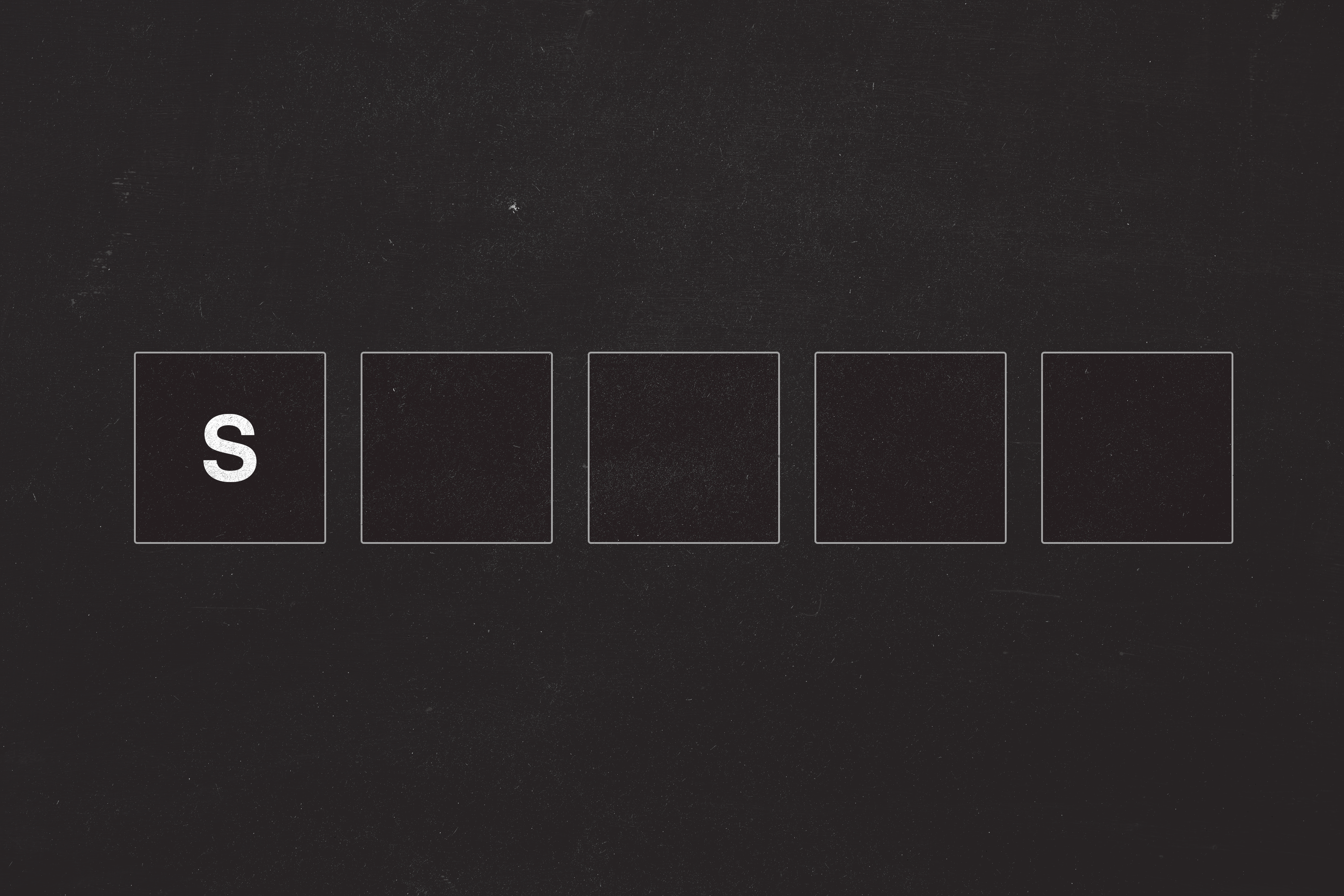What to Do When Playing the Word Game Wordle Isn’t Enough? Solve It.
Linguists, engineers, and puzzle obsessives unite in the quest for the perfect first word
If you’ve spent much time on Twitter in recent weeks, you’ve doubtless seen the grids of green, yellow, and gray squares that have swept across the platform. In what felt like the space of a few days, scorecards from the word game Wordle went from novel to unavoidable as a deluge of puzzlers eagerly compared their daily results.
The game is simple. Every day, players are asked to identify a new five-letter word in as many as six guesses. After each guess, Wordle tells players whether each letter was right (green), wrong (gray), or right but in the wrong position (yellow), gradually leading them closer to the solution. (There is also a color-blind mode that swaps the yellows for blues and greens for oranges.) The ostensible goal is to find the word in as few turns as possible, but—aside from a concluding grid with fewer rows of attempts—there is no reward to speak of.
Not that that has done much to dampen the Wordle craze. The game has drawn a cult following, from Jimmy Fallon to Blink-182’s Mark Hoppus to Gemma Styles to British MP Jess Phillips to Richard Osman. Since the game’s public launch in October, it has ballooned to more than 300,000 daily players—with many drawn at least in part by the game’s carefully structured scarcity. Just one Wordle puzzle appears each day, and as of yet there is no accessible—much less playable—database of previous days’ games. (“We want a Wordle archive and we want it now!!!” journalist Mina Kimes tweeted last week.)
By its very nature, Wordle inspires competition and comparison with other players. To finish a puzzle is to wonder how, and how efficiently, others did the same. Conversations about Wordle have a way of leading straight into debates over the ideal first word. Some words, surely, leave better clues than others. And if some words are better for kicking off the hunt, could it be that one might be best of all? Somewhere in the maze of 26 letters, is there a perfect diagnostic fivesome?
In a highly scientific (that is, not at all scientific) study of my Twitter followers, RATES and RAISE emerged as particular favorites. Some responses cited the wisdom of Wheel of Fortune, which automatically supplies players with the letters R, S, T, L, N, and E, on the basis of how common they are. More than a few respondents offered OUIJA and ADIEU to maximize vowels. Special credit to the user who informed me that they use the word “FARTS,” “Because if the word is ever FARTS and I get it on the first try it will be the best day of my life.”
With all due respect to FARTS, other Wordle players have taken their experiments a bit further. (Here is where I get into the nasty business of numbers, so if you’d like to keep your Wordle-ing free of probabilities, you’d be best not reading.)
Enter Adam Kubaryk, a high-performance computing model developer for CIRES. (“I code for a living, basically,” he says.)
Like so many others, Kubaryk came across Wordle on Twitter. But simply playing wasn’t enough. “When exposed to games like these, I don’t just enjoy solving them on my own: I like conquering them computationally,” Kubaryk says. “‘What’s your first word?’ is a fun question, but lends itself to logic about the game’s structure and knowledge of the English language. Wordle presents a unique opportunity to allow myself to play the game, but also bruteforce an optimal word from which to start.” And so, Kubaryk says, he awoke last weekend with a hangover and got to work. Four hours later, he had answers—and, more specifically, a Python-fueled solver.
Kubaryk’s script combed through a master list of five-letter words, eventually landing on SOARE (“a young hawk”) and SAINE (“to make the sign of the cross over so as to bless or protect from evil or sin”) as the openers that required the fewest rounds to solve and failed the solver least frequently, respectively—“neither of which I deem to be actual words but still use myself anyway,” Kubaryk says. From there, the solver could continue to other rounds. “Say you guess PAGER and get P in yellow and A in green; I could have the program spit out every word with A as the second letter and P in 3-5, or instead give you a short list of the words it deems to be most useful as your next guess.” (Distressingly, Kubaryk says that his examination of Wordle’s source code revealed that the game has a list of words that it will count as valid guesses but which will never be solutions—a list that includes FARTS.)
Kubaryk isn’t the only one to build a Wordle solver. Rob Miller, a London-based strategist at a creative agency, also tried his hand at cracking the first-word mystery.
“I can code and I’m interested in language, so most of my programming has been around text and language stuff, and it seemed like a fairly trivial thing for a computer to give an objectively correct answer to, so I hammered out a quick script,” he says. He, too, used a day off from work for the enterprise.
Like Kubaryk, Miller’s goal “was to try to figure out what the best first word was,” he says. “How I interpreted that was: Which single word is going to stand the highest chance of getting the highest number of matched letters? That means thinking about how often each letter crops up in five-letter words, but also how often it crops up in specific positions.”
“The best first word was TARES, followed by LARES, RALES, RATES, and CARES—‘-es’ is such a common ending that all the most common words end that way,” Miller says. (Quoth Ringer copy chief Craig Gaines on the subject of SOARE and SAINE: “Yeah, no. Big no on that. I don’t know whether Wordle has an official dictionary, but my dictionary (also, not coincidentally, The Ringer’s dictionary!) does not account for those profanities. I’m not into it.”)
Miller’s worst options: XYLYL, IMMIX, JUGUM, HYPHY, and OXBOW. “Possibly good words to learn if you want to be a tricksy Scrabble player; not so good for Wordle, although I guess Wordle could theoretically choose one of those words if it wanted to be really hideously horrible to people,” he added.
Kyle Mahowald is an assistant professor in linguistics at University of Texas at Austin whose research focuses on the efficiency of language. He is also a self-avowed “word game fan” who as a college freshman in 2005 became the youngest person to have a crossword puzzle published in The New York Times.
The key to Wordle, Mahowald says, “is to try to maximize the amount of information that you gain with each guess.”
“In the technical sense, information is related to how surprised you are: If you have gained information, it means you have learned something you couldn’t have already guessed ahead of time. So in Wordle, you want your guesses to tell you something you didn’t already know so as to help you maximally narrow down the possibility of what the word could be.”
But there are still good guesses and bad ones. He cites the example of guessing the word OZONE. The Z, Mahowald says, doesn’t provide much useful information: Given how uncommon the letter Z is in five-letter words, it “would have less than a 2 percent chance of turning yellow and less than a 0.1 percent chance of turning green. So 98 percent of the time that letter will tell you what you probably already knew: There’s no Z.”
The E, on the other hand, is much more useful. “I estimate that it has about a 34 percent chance of turning yellow—there is an E somewhere in there but not at the end—and a 12 percent chance of turning green—E is the last letter—and about a 44 percent chance of turning gray, i.e. there is no E in there at all. Now that’s a good amount of information, no matter what happens.” Mahowald developed his own program, one that favors opening words with E’s at the end and other commonly found letters ahead of them: STARE, RAISE, ARISE, SLATE, IRATE. This last bit, however, was information he was loath to part with: “I’m almost hesitant to spoil the fun,” he says.
When it comes to lousy openers, Mahowald is ready to forgive a misbegotten guess. “My program doesn’t like FUZZY, FIZZY, or JAZZY,” he says. “But these are such fun words and would all be great crossword answers.”
In the end, Mahowald says he favors the approach of writer and editor Helen Rosner. Rosner has abandoned the search for the perfect first word entirely. “I’ve started with a different word each time, mostly because I’ve been having fun coming up with obscure-feeling five-letter words—PANDA, SHEAF—and seeing where they take me,” she explains. “It’s kind of like randomizing a Rubik’s Cube before starting a solve.”
And indeed, efficiency can offer only so much: Kubaryk has left his solver mostly by the wayside.
“Even though I’m already using computer-aided assistance with my first guess, I see it as me against the game in the end, and I prefer that way in the same sense that I wouldn’t use a chess engine to solve a chess puzzle even if the engine analysis will help me understand chess better after I’ve failed the puzzle,” he says. “I have been checking how the solver does after the fact with various seed words, just because it satisfies a curiosity, but I’m not sure how much longer I’ll keep that up before getting bored.”

